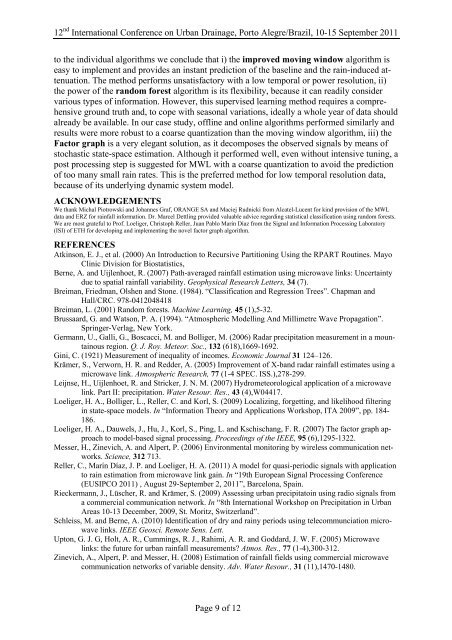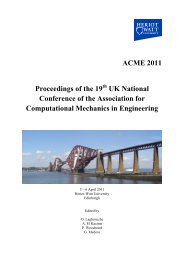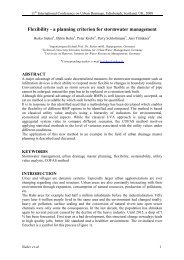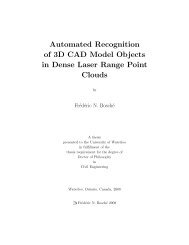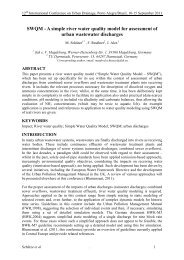Identification of dry and rainy periods using telecommunication ...
Identification of dry and rainy periods using telecommunication ...
Identification of dry and rainy periods using telecommunication ...
You also want an ePaper? Increase the reach of your titles
YUMPU automatically turns print PDFs into web optimized ePapers that Google loves.
12 nd International Conference on Urban Drainage, Porto Alegre/Brazil, 10-15 September 2011<br />
to the individual algorithms we conclude that i) the improved moving window algorithm is<br />
easy to implement <strong>and</strong> provides an instant prediction <strong>of</strong> the baseline <strong>and</strong> the rain-induced attenuation.<br />
The method performs unsatisfactory with a low temporal or power resolution, ii)<br />
the power <strong>of</strong> the r<strong>and</strong>om forest algorithm is its flexibility, because it can readily consider<br />
various types <strong>of</strong> information. However, this supervised learning method requires a comprehensive<br />
ground truth <strong>and</strong>, to cope with seasonal variations, ideally a whole year <strong>of</strong> data should<br />
already be available. In our case study, <strong>of</strong>fline <strong>and</strong> online algorithms performed similarly <strong>and</strong><br />
results were more robust to a coarse quantization than the moving window algorithm, iii) the<br />
Factor graph is a very elegant solution, as it decomposes the observed signals by means <strong>of</strong><br />
stochastic state-space estimation. Although it performed well, even without intensive tuning, a<br />
post processing step is suggested for MWL with a coarse quantization to avoid the prediction<br />
<strong>of</strong> too many small rain rates. This is the preferred method for low temporal resolution data,<br />
because <strong>of</strong> its underlying dynamic system model.<br />
ACKNOWLEDGEMENTS<br />
We thank Michal Piotrowski <strong>and</strong> Johannes Graf, ORANGE SA <strong>and</strong> Maciej Rudnicki from Alcatel-Lucent for kind provision <strong>of</strong> the MWL<br />
data <strong>and</strong> ERZ for rainfall information. Dr. Marcel Dettling provided valuable advice regarding statistical classification <strong>using</strong> r<strong>and</strong>om forests.<br />
We are most grateful to Pr<strong>of</strong>. Loeliger, Christoph Reller, Juan Pablo Marín Díaz from the Signal <strong>and</strong> Information Processing Laboratory<br />
(ISI) <strong>of</strong> ETH for developing <strong>and</strong> implementing the novel factor graph algorithm.<br />
REFERENCES<br />
Atkinson, E. J., et al. (2000) An Introduction to Recursive Partitioning Using the RPART Routines. Mayo<br />
Clinic Division for Biostatistics,<br />
Berne, A. <strong>and</strong> Uijlenhoet, R. (2007) Path-averaged rainfall estimation <strong>using</strong> microwave links: Uncertainty<br />
due to spatial rainfall variability. Geophysical Research Letters, 34 (7).<br />
Breiman, Friedman, Olshen <strong>and</strong> Stone. (1984). “Classification <strong>and</strong> Regression Trees”. Chapman <strong>and</strong><br />
Hall/CRC. 978-0412048418<br />
Breiman, L. (2001) R<strong>and</strong>om forests. Machine Learning, 45 (1),5-32.<br />
Brussaard, G. <strong>and</strong> Watson, P. A. (1994). “Atmospheric Modelling And Millimetre Wave Propagation”.<br />
Springer-Verlag, New York.<br />
Germann, U., Galli, G., Boscacci, M. <strong>and</strong> Bolliger, M. (2006) Radar precipitation measurement in a mountainous<br />
region. Q. J. Roy. Meteor. Soc., 132 (618),1669-1692.<br />
Gini, C. (1921) Measurement <strong>of</strong> inequality <strong>of</strong> incomes. Economic Journal 31 124–126.<br />
Krämer, S., Verworn, H. R. <strong>and</strong> Redder, A. (2005) Improvement <strong>of</strong> X-b<strong>and</strong> radar rainfall estimates <strong>using</strong> a<br />
microwave link. Atmospheric Research, 77 (1-4 SPEC. ISS.),278-299.<br />
Leijnse, H., Uijlenhoet, R. <strong>and</strong> Stricker, J. N. M. (2007) Hydrometeorological application <strong>of</strong> a microwave<br />
link. Part II: precipitation. Water Resour. Res., 43 (4),W04417.<br />
Loeliger, H. A., Bolliger, L., Reller, C. <strong>and</strong> Korl, S. (2009) Localizing, forgetting, <strong>and</strong> likelihood filtering<br />
in state-space models. In “Information Theory <strong>and</strong> Applications Workshop, ITA 2009”, pp. 184-<br />
186.<br />
Loeliger, H. A., Dauwels, J., Hu, J., Korl, S., Ping, L. <strong>and</strong> Kschischang, F. R. (2007) The factor graph approach<br />
to model-based signal processing. Proceedings <strong>of</strong> the IEEE, 95 (6),1295-1322.<br />
Messer, H., Zinevich, A. <strong>and</strong> Alpert, P. (2006) Environmental monitoring by wireless communication networks.<br />
Science, 312 713.<br />
Reller, C., Marín Díaz, J. P. <strong>and</strong> Loeliger, H. A. (2011) A model for quasi-periodic signals with application<br />
to rain estimation from microwave link gain. In “19th European Signal Processing Conference<br />
(EUSIPCO 2011) , August 29-September 2, 2011”, Barcelona, Spain.<br />
Rieckermann, J., Lüscher, R. <strong>and</strong> Krämer, S. (2009) Assessing urban precipitatoin <strong>using</strong> radio signals from<br />
a commercial communication network. In “8th International Workshop on Precipitation in Urban<br />
Areas 10-13 December, 2009, St. Moritz, Switzerl<strong>and</strong>”.<br />
Schleiss, M. <strong>and</strong> Berne, A. (2010) <strong>Identification</strong> <strong>of</strong> <strong>dry</strong> <strong>and</strong> <strong>rainy</strong> <strong>periods</strong> <strong>using</strong> telecommunciation microwave<br />
links. IEEE Geosci. Remote Sens. Lett.<br />
Upton, G. J. G, Holt, A. R., Cummings, R. J., Rahimi, A. R. <strong>and</strong> Goddard, J. W. F. (2005) Microwave<br />
links: the future for urban rainfall measurements? Atmos. Res., 77 (1-4),300-312.<br />
Zinevich, A., Alpert, P. <strong>and</strong> Messer, H. (2008) Estimation <strong>of</strong> rainfall fields <strong>using</strong> commercial microwave<br />
communication networks <strong>of</strong> variable density. Adv. Water Resour., 31 (11),1470-1480.<br />
Page 9 <strong>of</strong> 12


